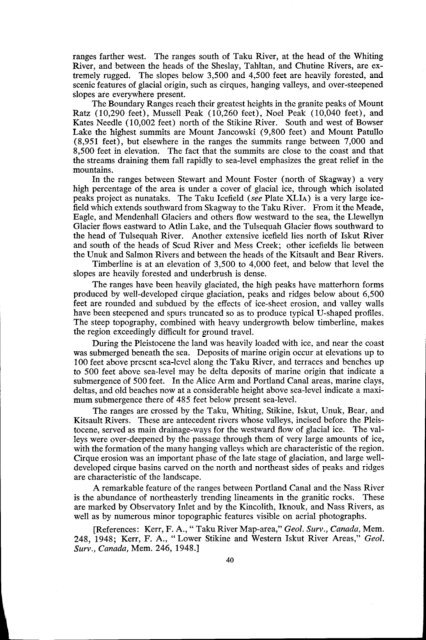Landforms of British Columbia 1976 - Department of Geography
Landforms of British Columbia 1976 - Department of Geography
Landforms of British Columbia 1976 - Department of Geography
Create successful ePaper yourself
Turn your PDF publications into a flip-book with our unique Google optimized e-Paper software.
anges farther west. The ranges south <strong>of</strong> Taku River, at the head <strong>of</strong> the Whiting<br />
River, and between the heads <strong>of</strong> the Sheslay, Tahltan, and Chutine Rivers, are ex-<br />
tremely rugged. The slopes below 3,500 and 4,500 feet are heavily forested, and<br />
scenic features <strong>of</strong> glacial origin, such as cirques, hanging valleys, and over-steepened<br />
slopes are everywhere present.<br />
The Boundary Ranges reach their greatest heights in the granite peaks <strong>of</strong> Mount<br />
Ratz (10,290 feet), Mussel1 Peak (10,260 feet), Noel Peak ( 10,040 feet), and<br />
Kates Needle ( 10,002 feet) north <strong>of</strong> the Stikine River. South and west <strong>of</strong> Bowser<br />
Lake the highest summits are Mount Jancowski (9,800 feet) and Mount Patullo<br />
(8,951 feet), but elsewhere in the ranges the summits range between 7,000 and<br />
8,500 feet in elevation. The fact that the summits are close to the coast and that<br />
the streams draining them fall rapidly to sea-level emphasizes the great relief in the<br />
mountains.<br />
In the ranges between Stewart and Mount Foster (north <strong>of</strong> Skagway) a very<br />
high percentage <strong>of</strong> the area is under a cover <strong>of</strong> glacial ice, through which isolated<br />
peaks project as nunataks. The Taku Icefield (see Plate XLIA) is a very large ice-<br />
field which extends southward from Skagway to the Taku River. From it the Meade,<br />
Eagle, and Mendenhall Glaciers and others flow westward to the sea, the Llewellyn<br />
Glacier flows eastward to Atlin Lake, and the Tulsequah Glacier flows southward to<br />
the head <strong>of</strong> Tulsequah River. Another extensive icefield lies north <strong>of</strong> Iskut River<br />
and south <strong>of</strong> the heads <strong>of</strong> Scud River and Mess Creek; other icefields lie between<br />
the Unuk and Salmon Rivers and between the heads <strong>of</strong> the Kitsault and Bear Rivers.<br />
Timberline is at an elevation <strong>of</strong> 3,500 to 4,000 feet, and below that level the<br />
slopes are heavily forested and underbrush is dense.<br />
The ranges have been heavily glaciated, the high peaks have matterhorn forms<br />
produced by well-developed cirque glaciation, peaks and ridges below about 6,500<br />
feet are rounded and subdued by the effects <strong>of</strong> ice-sheet erosion, and valley walls<br />
have been steepened and spurs truncated so as to produce typical U-shaped pr<strong>of</strong>iles,<br />
The steep topography, combined with heavy undergrowth below timberline, makes<br />
the region exceedingly ditlicult for ground travel.<br />
During the Pleistocene the land was heavily loaded with ice, and near the coast<br />
was submerged beneath the sea. Deposits <strong>of</strong> marine origin occur at elevations up to<br />
100 feet above present sea-level along the Taku River, and terraces and benches up<br />
to 500 feet above sea-level may be delta deposits <strong>of</strong> marine origin that indicate a<br />
submergence <strong>of</strong> 500 feet. In the Alice Arm and Portland Canal areas, marine clays,<br />
deltas, and old beaches now at a considerable height above sea-level indicate a maxi-<br />
mum submergence there <strong>of</strong> 485 feet below present sea-level.<br />
The ranges are crossed by the Taku, Whiting, Stikine, Iskut, Unuk, Bear, and<br />
Kitsault Rivers. These are antecedent rivers whose valleys, incised before the Pleis-<br />
tocene, served as main drainage-ways for the westward flow <strong>of</strong> glacial ice. The val-<br />
leys were over-deepened by the passage through them <strong>of</strong> very large amounts <strong>of</strong> ice,<br />
with the formation <strong>of</strong> the many hanging valleys which are characteristic <strong>of</strong> the region.<br />
Cirque erosion was an important phase <strong>of</strong> the late stage <strong>of</strong> glaciation, and large well-<br />
developed cirque basins carved on the north and northeast sides <strong>of</strong> peaks and ridges<br />
are characteristic <strong>of</strong> the landscape.<br />
A remarkable feature <strong>of</strong> the ranges between Portland Canal and the Nass River<br />
is the abundance <strong>of</strong> northeasterly trending lineaments in the granitic rocks. These<br />
are marked by Observatory Inlet and by the Kincolith, Iknouk, and Nass Rivers, as<br />
well as by numerous minor topographic features visible on aerial photographs.<br />
[References: Kerr, F. A., “ Taku River Map-area,” Geol. Surv., Cunudu, Mem.<br />
248, 1948; Kerr, F. A., “ Lower Stikine and Western Iskut River Areas,” GeoZ.<br />
Surv., Canada, Mem. 246, 1948.1<br />
40











